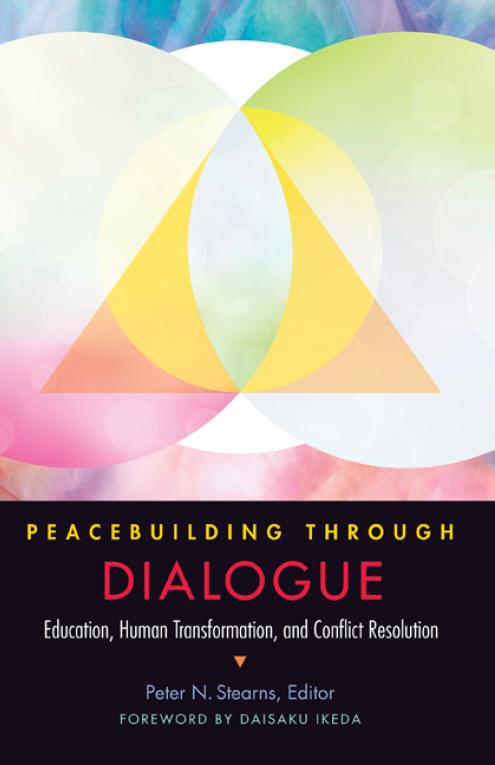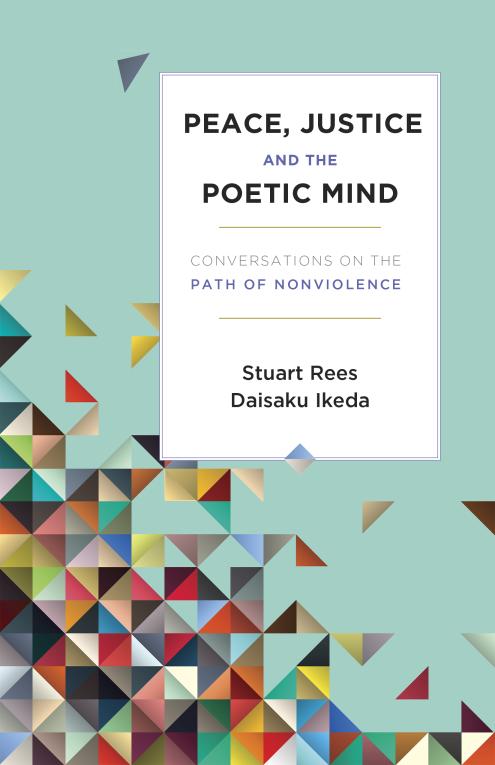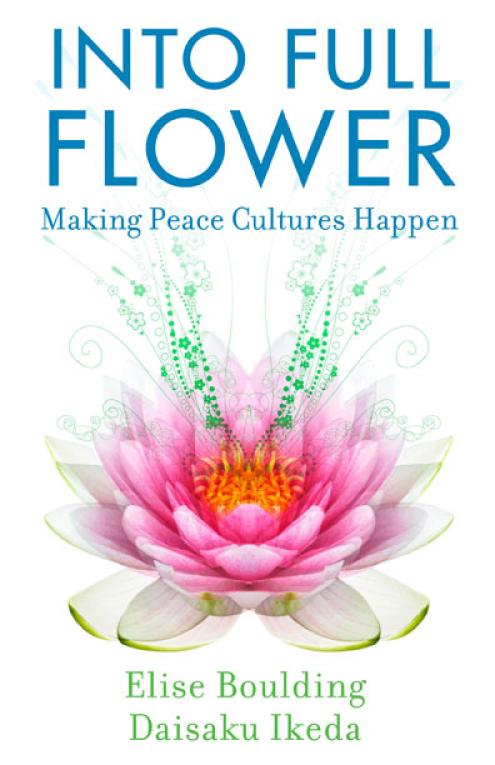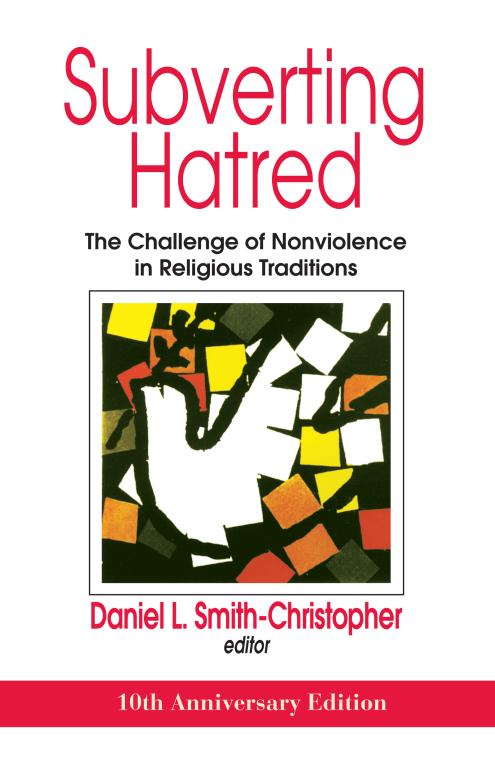
Peacebuilding Through Dialogue: Education, Human Transformation, and Conflict Resolution
For ordering and exam copy information see the
Peacebuilding Through Dialogue page at the
University of Virginia Press website.
ISBN: 978-1-942695-11-0
Peacebuilding Through Dialogue is an invitation to scholars, students, and engaged citizens to discover the power and versatility of dialogue as a peacebuilding practice. Edited by Peter Stearns, the book features sixteen authors considering dialogue in the context of teaching and learning; dialogue as part of personal and interpersonal growth; and dialogue in conflict resolution and other situations of great change. With its expansive approach, the book makes original and invaluable contributions to peace studies, civic studies, education studies, organizational studies, conflict resolution studies, and dignity studies.
“This vibrant, insightful volume sheds new light on dialogue processes that serve as the DNA of peacebuilding and help bridge the chasms of deeply divided societies. The book is especially groundbreaking in its focus on the links between ‘inner peace,’ including dynamics such as compassion and dignity, and broad social change. It is this constant interplay between transformation of the self and transformation of society that gives dialogue its tensile strength, and the authors capture these dynamics compellingly. In an increasingly polarized world, this book offers hope and a reflection on how we can change society, and ourselves.”
—Melanie Greenberg, Managing Director for Peacebuilding, Humanity United; former Chief Executive Officer, the Alliance for Peacebuilding
“This set of chapters on the use of dialogue in peacebuilding is powerfully informative and beautifully written. Engaging in dialogue is challenging work, and this fine book provides substantial help.”
—Nel Noddings, Lee L. Jacks Professor of Education, Emerita, at Stanford University; author, Caring: A Feminine Approach to Ethics and Moral Education
”Peacebuilding Through Dialogue is a valuable collection of reflections on the meaning, complexity, and application of dialogue. Any student and/or practitioner of dialogue, including peace and justice educators, will find important value in these essays from a diverse range of scholars and practitioners. The volume offers in-depth and rigorous insight into the theory and practice of dialogue in education, personal development, and [conflict resolution], insight that seems of even greater ethical and political importance today.”
—Dale Snauwaert, Professor, Educational Theory and Social Foundations of Education, University of Toledo
“With the themes of respect for human dignity, spirit of mutuality, and creativity as common threads, all three sections [of Peacebuilding Through Dialogue] cohere into a comprehensive whole illustrating the deeply educative role that persistent dialogue can and does play in fostering the type of human becoming that educators and the field of education endeavor to effect in theory and practice, a becoming born from inner transformation that leads to mutual growth and creativity. Moreover, taken together, the chapters in this volume clarify that whether ameliorating differences among seemingly different groups in the classroom, mediating international conflicts, or collaboratively solving local issues through dialogic engagement, fruitful dialogue requires dispositions and skills that must be cultivated, and thus all of the chapters have important implications for education.”
—Nozomi Inukai, Research Fellow, Institute for Daisaku Ikeda Studies in Education, DePaul University
Peter N. Stearns is University Professor and Provost Emeritus at George Mason University.
Foreword
Daisaku Ikeda
Dialogue: An Introduction
Peter N. Stearns
SECTION ONE: EDUCATION
1. Identity, Race, and Classroom Dialogue
Steven D. Cohen
2. Listening and Dialogue in Educators’ Reflective Practice
Bradley Siegel and William Gaudelli
3. The Presence and Role of Dialogue in Soka Education
Jason Goulah
4. Dialogue and Agency: Educating for Peace and Social Change
Monisha Bajaj and Ion Vlad
SECTION TWO: PERSONAL AND INTERPERSONAL TRANSFORMATION
5. Compassion in Dialogue
Bernice Lerner
6. Bringing Out the Best in Oneself and Others: The Role of Dialogue in Daisaku Ikeda’s Peacebuilding Practice
Olivier Urbain
7. The WISE Model and the Role of Self As Observer in Genuine Dialogue
Meenakshi Chhabra
8. Values, Dissonance, and the Creation of Shared Meaning
Gonzalo Obelleiro
SECTION THREE: CONFICT RESOLUTION
9. Dignity Dialogues: An Educational Approach to Healing and Reconciling Relationships in Conflict
Donna Hicks
10. Changing the Conversation: Emerging Better Dialogue Practices Through Four Lenses
Mark Farr
11. Dialogue and Mutual Recognition: The Practice of Interreligious Encounters|
Andrea Bartoli and Charles Gardner
12. Modes of Peacemaking Dialogue
Susan H. Allen
13. Dialogue and Demographic Complexity
Ceasar L. McDowell
Conclusion
Peter N. Stearns
Works Cited
Index
Author Biographies
Excerpt from the foreword by Daisaku Ikeda
“In order to achieve mutually enriching, deeply connecting dialogue, we need to overcome the divisions within our own hearts that make us unconsciously categorize people and rank their value on that basis. We need to be aware of the danger of categorizing people into such simplistic binaries as good and bad, us and them, and friend and foe. Such an approach is one of the deep drivers of conflict.”
Excerpt from the introduction by Peter Stearns
“Enthusiasm for dialogue always risks accusations of undue idealism, of neglect of harsh practical realities. The essays that follow undeniably express idealistic commitments, but they also show dialogue at work in a number of applications, from classrooms to conferences.They suggest a variety of tested and achievable steps to extend dialogue in various settings. Dialogue connects directly to a number of measurable achievements, not just in the past but in current programs to advance effective learning or resolve disputes among conflicting factions…
“Ultimately, in the contemporary world, the primary goal of dialogue is to serve the promotion of peace—and this applies to its role in facilitating greater understanding of complex issues in the classroom and in promoting personal transformations, as well as its service in conflict arenas. Each of the essay’s authors reflects this goal by addressing the challenges that confront them—illustrating Daisaku Ikeda’s (2004) core belief that even transforming single individuals ‘will enable a change in the destiny of all mankind’ (p. iii). Not only the results but also the process of sincere dialogue move all participants toward more peaceful interactions, in turn the greatest need of the world we live in.”
Description
Peacebuilding Through Dialogue is an invitation to scholars, students, and engaged citizens to discover the power and versatility of dialogue as a peacebuilding practice. Edited by Peter Stearns, the book features sixteen authors considering dialogue in the context of teaching and learning; dialogue as part of personal and interpersonal growth; and dialogue in conflict resolution and other situations of great change. With its expansive approach, the book makes original and invaluable contributions to peace studies, civic studies, education studies, organizational studies, conflict resolution studies, and dignity studies.
Advance Praise
“This vibrant, insightful volume sheds new light on dialogue processes that serve as the DNA of peacebuilding and help bridge the chasms of deeply divided societies. The book is especially groundbreaking in its focus on the links between ‘inner peace,’ including dynamics such as compassion and dignity, and broad social change. It is this constant interplay between transformation of the self and transformation of society that gives dialogue its tensile strength, and the authors capture these dynamics compellingly. In an increasingly polarized world, this book offers hope and a reflection on how we can change society, and ourselves.”
—Melanie Greenberg, Managing Director for Peacebuilding, Humanity United; former Chief Executive Officer, the Alliance for Peacebuilding
“This set of chapters on the use of dialogue in peacebuilding is powerfully informative and beautifully written. Engaging in dialogue is challenging work, and this fine book provides substantial help.”
—Nel Noddings, Lee L. Jacks Professor of Education, Emerita, at Stanford University; author, Caring: A Feminine Approach to Ethics and Moral Education
”Peacebuilding Through Dialogue is a valuable collection of reflections on the meaning, complexity, and application of dialogue. Any student and/or practitioner of dialogue, including peace and justice educators, will find important value in these essays from a diverse range of scholars and practitioners. The volume offers in-depth and rigorous insight into the theory and practice of dialogue in education, personal development, and [conflict resolution], insight that seems of even greater ethical and political importance today.”
—Dale Snauwaert, Professor, Educational Theory and Social Foundations of Education, University of Toledo
“With the themes of respect for human dignity, spirit of mutuality, and creativity as common threads, all three sections [of Peacebuilding Through Dialogue] cohere into a comprehensive whole illustrating the deeply educative role that persistent dialogue can and does play in fostering the type of human becoming that educators and the field of education endeavor to effect in theory and practice, a becoming born from inner transformation that leads to mutual growth and creativity. Moreover, taken together, the chapters in this volume clarify that whether ameliorating differences among seemingly different groups in the classroom, mediating international conflicts, or collaboratively solving local issues through dialogic engagement, fruitful dialogue requires dispositions and skills that must be cultivated, and thus all of the chapters have important implications for education.”
—Nozomi Inukai, Research Fellow, Institute for Daisaku Ikeda Studies in Education, DePaul University
Author(s)
Peter N. Stearns is University Professor and Provost Emeritus at George Mason University.
Table of Contents
Foreword
Daisaku Ikeda
Dialogue: An Introduction
Peter N. Stearns
SECTION ONE: EDUCATION
1. Identity, Race, and Classroom Dialogue
Steven D. Cohen
2. Listening and Dialogue in Educators’ Reflective Practice
Bradley Siegel and William Gaudelli
3. The Presence and Role of Dialogue in Soka Education
Jason Goulah
4. Dialogue and Agency: Educating for Peace and Social Change
Monisha Bajaj and Ion Vlad
SECTION TWO: PERSONAL AND INTERPERSONAL TRANSFORMATION
5. Compassion in Dialogue
Bernice Lerner
6. Bringing Out the Best in Oneself and Others: The Role of Dialogue in Daisaku Ikeda’s Peacebuilding Practice
Olivier Urbain
7. The WISE Model and the Role of Self As Observer in Genuine Dialogue
Meenakshi Chhabra
8. Values, Dissonance, and the Creation of Shared Meaning
Gonzalo Obelleiro
SECTION THREE: CONFICT RESOLUTION
9. Dignity Dialogues: An Educational Approach to Healing and Reconciling Relationships in Conflict
Donna Hicks
10. Changing the Conversation: Emerging Better Dialogue Practices Through Four Lenses
Mark Farr
11. Dialogue and Mutual Recognition: The Practice of Interreligious Encounters|
Andrea Bartoli and Charles Gardner
12. Modes of Peacemaking Dialogue
Susan H. Allen
13. Dialogue and Demographic Complexity
Ceasar L. McDowell
Conclusion
Peter N. Stearns
Works Cited
Index
Author Biographies
Excerpts
Excerpt from the foreword by Daisaku Ikeda
“In order to achieve mutually enriching, deeply connecting dialogue, we need to overcome the divisions within our own hearts that make us unconsciously categorize people and rank their value on that basis. We need to be aware of the danger of categorizing people into such simplistic binaries as good and bad, us and them, and friend and foe. Such an approach is one of the deep drivers of conflict.”
Excerpt from the introduction by Peter Stearns
“Enthusiasm for dialogue always risks accusations of undue idealism, of neglect of harsh practical realities. The essays that follow undeniably express idealistic commitments, but they also show dialogue at work in a number of applications, from classrooms to conferences.They suggest a variety of tested and achievable steps to extend dialogue in various settings. Dialogue connects directly to a number of measurable achievements, not just in the past but in current programs to advance effective learning or resolve disputes among conflicting factions…
“Ultimately, in the contemporary world, the primary goal of dialogue is to serve the promotion of peace—and this applies to its role in facilitating greater understanding of complex issues in the classroom and in promoting personal transformations, as well as its service in conflict arenas. Each of the essay’s authors reflects this goal by addressing the challenges that confront them—illustrating Daisaku Ikeda’s (2004) core belief that even transforming single individuals ‘will enable a change in the destiny of all mankind’ (p. iii). Not only the results but also the process of sincere dialogue move all participants toward more peaceful interactions, in turn the greatest need of the world we live in.”


